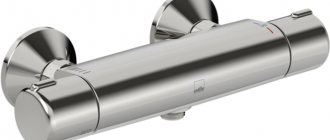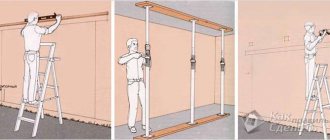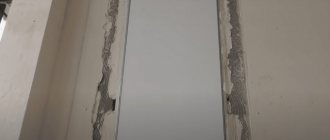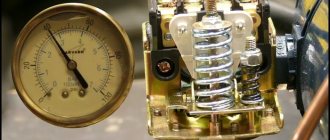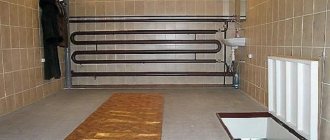To prevent doors from remaining open, they used to use a banal spring, but today they install a door closer. Its design is also based on a spring, but it is more powerful, hidden in a metal case and filled with oil - for “braking” when closing. Installing a door closer is not a difficult task. Self-installation will take 20-30 minutes. Hardly any more. So we take a drill and install it ourselves.
Most popular model
How it works
All regular door closers are based on a regular door lock.
, which, in addition to the electric drive for unlocking and locking, uses another one that is in charge of fine-tuning the door. The lock has a built-in Hall sensor, which determines that the door is closed “at the first click.” The electronic unit issues a command to the electric drive to tighten the door.
Locks with closers, installed on many VW Group vehicles, have the same structural diagram: a lock and an electric drive module connected to it by a cable.
Locks with closers, installed on many VW Group vehicles, have the same structural diagram: a lock and an electric drive module connected to it by a cable.
BMW closer operation diagram: when the door is closed, the rotating latch (2) engages the bracket (1). In this position, the Hall sensor (3) sends a signal to the control unit that the door is not closed tightly. An electric drive (6), consisting of a motor and a two-stage gearbox, tensions the cable (5) and moves the lever (4). The lever presses the rotating latch, which pulls the door “on the second click.” The latch is fixed, the electric drive is turned off.
BMW closer operation diagram: when the door is closed, the rotating latch (2) engages the bracket (1). In this position, the Hall sensor (3) sends a signal to the control unit that the door is not closed tightly. An electric drive (6), consisting of a motor and a two-stage gearbox, tensions the cable (5) and moves the lever (4). The lever presses the rotating latch, which pulls the door “on the second click.” The latch is fixed, the electric drive is turned off.
To close the trunk lid, in some cases, closers with a “reverse” circuit are used. The lid is tightened due to the fact that the bracket to which the lock clings crawls “deeper” into the threshold of the luggage compartment.
Luggage compartment lid closer.
Luggage compartment lid closer.
Types of closers and installation methods
Installing a mechanical device that smoothly closes the door reduces the load on the fittings and protects the hinges and the structure itself from premature wear. You can equip it with an entrance door, an interior door, and a door between the house and the bathhouse extension or garage.
Differences in the installation method determined the classification of closers, which are divided into:
- overhead mechanisms installed on box beams or on the canvas, or in door hinges instead of the rod;
- floor structures, the laying of which is carried out during the installation of the floor covering and is usually designed in advance;
- hidden devices located either in the box if its power is sufficient, or in the canvas. To equip this type of mechanism, cavities must be milled, which should not be undertaken without experience.
The simplest and most accessible for an inexperienced performer would be the overhead installation of a door closer, the process of which in most cases is described in detail by the manufacturer. Caring manufacturers now include with their products not only a detailed description, but also a template that accurately follows the contour of the mechanism with clearly marked points for fastening. Almost all actions are carried out according to the standard algorithm, but there are nuances that should not be forgotten.
Attention. Before equipping the door with the device, it must be repaired and the fittings adjusted. The canvas should not “shuffle” along the floor or hang crookedly on its hinges. The movement of the loops should not be heavy.
Construction installation options
Mechanisms with levers or sliding channels can be mounted both on the inside and outside of the interior door structure. It is undesirable to install the device only on the outside of entrance doors due to the negative influence of characteristic changes in atmospheric temperature.
The fact is that the smooth movement of the spring controlling the lever ensures the variable flow of machine oil from one cavity to another. And in cold weather it becomes more viscous and thick, and in hot weather it becomes more liquid. Therefore, due to temperature fluctuations, the operation of the device will have to be adjusted more often than specified by the manufacturer, which ultimately reduces the operating life of the system.
You can choose one of three common installation schemes:
- The standard installation predetermines the fixation of the main working body on the canvas. With this arrangement, the lever is attached to the lintel of the door frame.
- The upper diagram dictates the fastening of the mechanism to the ceiling - the upper box beam, and the lever shoe is screwed to the door leaf.
- The parallel arrangement is similar to the standard version, but the lever is not attached perpendicularly, but in parallel using a mounting bracket.
The installation diagram of the door closer depends on the location of the hinges. That is, from the direction of movement of the canvas when opening/closing. If the door is opened “pull”, then the device is mounted as standard on the door leaf, and the lever is attached to the box beam. The “on your own” option obviously involves top mounting of the device to the lintel with fixation of the lever on the canvas.
There are also non-standard cases, such as, for example, insufficient door clearance. But cunning developers found a way out of structurally difficult situations by offering mounting angles and plates to home and professional craftsmen.
The installation of a door closer in such cases is carried out in a parallel scheme in two ways:
- the lever is secured in parallel, placing its shoe on the mounting angle fixed on the box;
- The main body of the closer is attached to the box beam using a mounting plate.
Briefly about door closers with sliding rod
Sliding rod devices are attractive due to their optimized design, which practically does not interfere with the interior decor. Among the advantages is the ability to upgrade the device with an electromagnetic clamp or fire alarm. Such closers operate with great force, and there is no way to control their operation, but equipping them with an elastic limiter insert will allow you to set the required opening angle of the sash. Most modifications are installed according to schemes similar to the perpendicular option described above. But universal models with a sliding channel rod can be mounted on both sides.
Attention. Installation of duct (slider) closers on the side opposite the location of the door hinges dictates that the device be equipped with a door leaf opening angle limiter. It can be replaced by a specialized stopper built into the slider.
How does it work
In appearance, the electric drive resembles a gas-filled tailgate stop - only thicker and longer (according to the laws of mechanics, greater movement requires less force). In addition, numerous devices must fit inside. The main element is a screw-nut pair that passes through almost the entire drive. An electric motor is installed at the end, which rotates the lead screw through a reduction planetary two-stage gearbox. A coil spring that works in compression helps lift a heavy door.
Luggage compartment door drive: 1 — Hall sensor; 2 - electric motor; 3 - gearbox; 4 — lead screw nut; 5 - spring; 6 - lead screw.
Luggage compartment door drive: 1 — Hall sensor; 2 - electric motor; 3 - gearbox; 4 — lead screw nut; 5 - spring; 6 - lead screw.
A device with feedback is required
, indicating that the device has reached one of two extreme positions.
This role is played by the Hall sensor, which controls the rotation of the motor armature. The operation of the two drives is controlled by an electronic unit. The tailgate can be opened by command from the remote control, or by pressing the button on the door when the car is disarmed, or, finally, in the most effective way - by running your foot under the bumper.
You can close the opening from the remote control by pressing a button on the door trim or a button from the interior.
Door closer installation algorithm
After carefully choosing the correct location and defining the layout, further actions are performed in an almost identical sequence:
- We apply the included template and glue it with tape to the installation site;
- through the designated locations of future holes for fasteners, there should be 2 for the lever and 4 for the device;
- It is advisable to drill the mounting holes in advance;
- First we attach the lever, followed by the body;
- After fixing the device and the lever, install the second half of the rod on the axis of the closer and make adjustments to the length. The lever must be strictly perpendicular to the closed door leaf.
Attention. The adjusting screws should be directed towards the hinge beam of the box.
The complete set of fasteners is supplied by the manufacturer; there is no need to buy or replace it with other hardware. It is important not to deviate one iota from the instructions, and success is guaranteed.
Safety
The working stroke of the side door closers is so small (6–7 mm) that only a finger can be pinched. On the interior side, the manufacturer does not leave any places where, for example, a child could find a gap in which a finger would be pinched. But the outer edges of the door still form gaps. However, you can only put a pencil in there.
This is how the Audi Q8 door closer bites through a pencil.
This is how the Audi Q8 door closer bites through a pencil.
Children should not operate the tailgate drives. Well, for an adult, the maximum force developed by the drive and not exceeding 10 kg at the edge of the door is not dangerous. If this force is exceeded, the door stops and even - on some cars - begins to open.
Spring hinges for doors: advantages
Hinges of this type work due to the main component - the spring. When moving, it returns the door leaf to its original state, providing a slight movement in both working directions.
Spring hinges installed indoors provide the following advantages:
- Heat conservation and draft-free.
- Convenient use of doors even with busy hands by not using them, which serves as a useful function in restaurants, bars, subways, medical institutions and offices.
- Providing trouble-free passage in cases of mass gatherings and large numbers of people.
- There is no need to close the doors, since this process occurs independently.
- Possibility to install them yourself.
Spring hinges for doors have a number of advantages
The choice of spring hinges does not seem difficult. When choosing, you should take into account some features and important details, such as the direction of movement, you need to take into account the desired side where the doors will move - right/left. It is also possible to purchase universal hinges.
The width of the parts is selected according to the dimensions of the door base, which should be given utmost emphasis. The weight the loop can support must be determined immediately, focusing on standard options (about 20-60 kg per loop). Knowing the required weight, it is possible to determine the required number of loops.
Species characteristics are important; loops can have significant differences in length and color. Common sizes are 7.5x10x12.5 cm, colors are bronze, brass, chrome, gold, nickel. It is also worth considering the ability to control the speed of closing doors and parts that provide smooth and silent movement.
Rear doorman
For ease of use of the trunk, we came up with a hands-free access system
. We have already discussed the principle of its operation. And here is how the power drive of the luggage compartment lid works.
An electric motor with a gear reducer that turns the lid by its hinges.
An electric motor with a gear reducer that turns the lid by its hinges.
Moreover, such devices are used both on heavy fifth doors of station wagons and on the lids of sedans.
There are also cars with a hydraulically driven trunk lid.
, but
the drive in the form of a sliding rod with a built-in electric drive
.
Hydraulic drive of the trunk lid of the Volkswagen Phaeton sedan: 1 - hydraulic cylinder; 2 - hydraulic unit; 3 - electric motor; 4 — trunk loop.
Hydraulic drive of the trunk lid of the Volkswagen Phaeton sedan: 1 - hydraulic cylinder; 2 - hydraulic unit; 3 - electric motor; 4 — trunk loop.
Preventative work
In order to avoid frequent repairs of the closer, you should follow a few simple rules that will help extend its service life and maintain high-quality operation under any conditions. So, when the closer operates, you do not need to put in any additional effort; the door will close itself. If you speed up or slow down the process, the lever mechanism or spring may fail. In cases where the door is forced to lock, the lever is disconnected from the closer. Often they do not know about this and spacers, barriers in the form of bricks, stones and the like are installed.
If the closer is installed outside, then care must be taken to design an additional protective casing that protects against frost, heat, and precipitation. Following basic methods of preventing damage will increase the service life of the door. Adjusting the door closer yourself is a simple and reliable means of saving material costs and time. It is not always possible to call a door service specialist. It’s not difficult to do it yourself, following all the steps.
Did you know that...
Some actuators begin to close the door when a person pulls the tailgate down slightly, indicating a desire to close it. Remember a computer CD-ROM: give it a little push and the tray slides away on its own.
The device allows you to implement an interesting function - the door is raised not to its full height, but by an amount programmed by the driver. This may be required in a garage with a low ceiling. The Hall sensor allows the “electronic intelligence” to count the number of revolutions of the electric motor that are necessary to lift the door to a given height. You can set the door lift height by pressing a button on the remote control or on the door itself.
Ways to control the door drive: 1 - button on the instrument panel; 2 — button on the door outside; 3 — button on the end of the door; 4 — button on the key fob.
Ways to control the door drive: 1 - button on the instrument panel; 2 — button on the door outside; 3 — button on the end of the door; 4 — button on the key fob.
Portal about construction
01/18/2019 admin Comments No comments
To protect the door from premature failure, closers are often used. These devices are designed to smoothly and accurately slam the door leaf. A specific model is selected based on many factors:
- temperature changes;
- expected load;
- the weight of the canvas itself;
- required level of reliability.
Often such mechanisms cost a lot, and if for external doors this is justified by the reliable service of purchased devices, then for internal doors or a summer house it is more economical to make a homemade closer.

